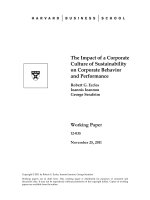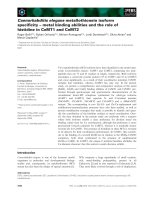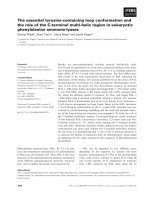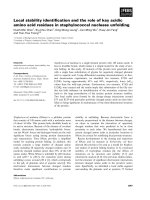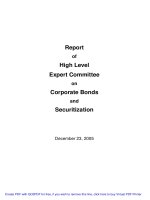essays on corporate strategy- evolution of corporate capabilities and the role of intangible assets
Bạn đang xem bản rút gọn của tài liệu. Xem và tải ngay bản đầy đủ của tài liệu tại đây (974.74 KB, 157 trang )
i
i
ESSAYS ON CORPORATE STRATEGY: EVOLUTION
OF CORPORATE CAPABILITIES AND
THE ROLE OF INTANGIBLE ASSETS
DISSERTATION
Presented in Partial Fulfillment of the Requirements for
the Degree Doctor of Philosophy in the Graduate School
of The Ohio State University
By
Asli Musaoglu Arikan, MBA
*****
The Ohio State University
2004
Dissertation Committee: Approved by
Professor Jay Barney, Adviser
Professor Karen Wruck
Professor David Hirshleifer _________________________
Professor Anita McGahan Adviser
Professor Konstantina Kiousis Business Administration Graduate Program
Professor Oded Shenkar
i
i
Copyright by
Asli Musaoglu Arikan
2004
ii
ABSTRACT
This dissertation is comprised of in depth analysis on the broader topic of
corporate strategy with emphasis of the role of intangible assets. The first chapter looks at
the performance implications of acquiring firms that have highly intangible assets
structures. The second essay looks at dynamic characteristics as well as outcomes of
developing intangible yet valuable corporate level capabilities in relation to managing
alliances and acquisitions. The final section looks at the role of intangible assets in
contracting between and within firms by utilizing property rights theory and the resource
based view.
A consistent finding regarding mergers and acquisitions (M&A) is that: on
average shareholders of target firms earn significant economic gains whereas
shareholders of acquiring firms break-even (Jensen and Ruback, 1983; Jarrell et. al.,
1988). Despite this general finding M&A activity has persisted, increasing in number and
transaction value because, managers often perceive M&A activity as a mechanism for
growth (e.g. Penrose, 1959). Therefore, it is natural to ask, `What type of assets are worth
buying?'
This paper investigates the long-run performance effects of acquiring intangible
versus tangible targets. Intangibility of target is proxied by multiple measures based on
iii
R&D, advertisement and human capital stocks, and the Tobin's q 1-year prior to the
corporate event. Using a sample of M&A transactions spanning a 4 year period (1988-
1991), long-run-buy-and-hold expected returns are calculated by constructing portfolios
of cohort firms that pursue M&A activity and tracked for 5 years. Each firm's long-run-
abnormal performance is calculated as the excess return to the benchmark portfolio.
Results show that on average, acquirers of intangible targets earn negative abnormal
returns, whereas acquirers of tangible targets break-even. However, for the whole sample,
there is no evidence of long-run abnormal returns.
Existence of asymmetric misvaluation between M&As of intangible versus
tangible targets is tested by regressing short-run returns on the buy-and-hold long-run
returns. Results provide evidence for market overreaction to the announcements that
involve highly intangible targets. Overall, findings suggest that on average, ownership
claim to the target's intangible assets via M&A does not transfer the associated economic
value.
In the second section I investigate how long it takes for publicly traded firms
within the United States to develop corporate capabilities for conducting alliances and
acquisitions effectively. The development of corporate capabilities has been difficult to
study directly because little information has been available on the accumulation at the
corporate level of performance-enhancing knowledge. The research reported here relies
on a dataset that tracks the behavior of the 3,595 firms that went through an initial public
iv
offering (IPO) between 1988 and 1999 to show how quickly corporate capabilities
developed from the earliest years of firm formation.
In particular, we conduct an event-study analysis to investigate how the abnormal
returns to alliance and acquisition announcements changed as the firms accumulated
experience in conducting deals of each type. The results suggest that firms accumulated
capabilities for executing and managing both alliances and acquisitions, and that
investors came to expect that firms would continue to exploit their specialized
capabilities into the future.
Finally I provide discussion of the theoretical implications of the empirical
findings and contribute to the literature on corporate strategy and resources based view
by incorporating insights from the property rights literature which can be considered as
the recent development extension of transaction cost economics.
v
Dedicated to my grandmother, Guzide Egilmez
vi
ACKNOWLEDGMENTS
I wish to thank my adviser Jay Barney, and my committee members David
Hirshleifer, Konstantina Kiousis, Anita McGahan, Oded Shenkar, and Karen Wruck for
their intellectual support, encouragement, and enthusiasm which made this thesis
possible.
I am grateful to Ilgaz Arikan for his continued support and stimulating discussions
on all aspects of my research interests.
I wish to also thank to Laurence Capron, Russ Coff, Ken Hatten, Anne-Marie
Knott, Harbir Singh, Ralph Walkling, Julie Wulf, and Bernard Yeung for their helpful
comments. The author also benefited from discussions with Josh Lerner, Dan Levinthal,
Jan Rivkin, Anju Seth, Jamal Shamsie, Scott Shane and Sid Winter. All the errors remain
mine.
vii
VITA
December 1, 1972…………Born – Izmir, Turkey
1994……………………….BS Istanbul technical University, Istanbul Turkey
1997 ………………………MBA University of North Carolina
2003-Current …………… Instructor, Boston University
PUBLICATIONS
Barney J.B., Arikan A.M. 2002. The resource-based view. Origins and implications. In
Hitt M.A., Freeman R.E., Harrison J.S. (eds.), Handbook of Strategic
Management. Blackwell Publishers: Oxford, UK; 124-188.
Arikan, A.M. 2002. Does it pay to capture intangible assets through mergers and
acquisitions? Academy of Management Meetings Best Paper Proceedings
Arikan, A.M. 2003. Does it pay to capture intangible assets through mergers and
acquisitions? In Strategic Management Society Book Series on M&A Summit
Arikan, A.M. 2003. Cross-border mergers and acquisitions: What have we learned? In
B.J. Punnett, and O. Shenkar (Eds.) 2
nd
Edition of Handbook of International
Management Research, University of Michigan Press
FIELDS OF STUDY
Major Field: Business Administration
Minor Field: Financial Economics
viii
TABLE OF CONTENTS
Page
Abstract ii
Dedication vi
Acknowledgments vi
Vita………………… vii
List of Tables x
List of Figures xii
Chapters:
1. Introduction 1
2. What Type Of Assets Is Worth Buying Through Mergers & Acquisition? 5
2.1 Resource-Based View And Competitive Advantage 8
2.2 Controls For Other Factors 11
2.2.1 Agency Motives 12
2.2.2 Information Asymmetry And Financing Of Intangible Assets 14
2.2.3 Market Over- Or Under-Valuation Of Growth Opportunities 17
2.3 Methodology And Data 20
2.3.1 Valuation Of Intangible Assets 21
2.3.2 Which Measure Of Performance? 24
2.3.3 Why Not Traditional Event Methodology? 26
2.3.4 Long Run Buy & Hold Abnormal Returns 29
2.3.5 Calculating Reference Portfolios 31
2.4 Data 32
2.5. Results 36
2.6 Discussion And Conclusion 44
3. How Long Does It Take To Build Corporate Capabilities For Conducting
Alliances And Acquisitions? 50
3.1 Antecedents 51
3.2 Theory And Hypothesis 53
3.2.1 Industry And Time Effects 58
3.3 Data 59
3.4 Descriptive Statistics 61
3.5 Methods 64
3.6 Results 66
ix
3.7 Conclusion 72
4. Why Do We Observe Heterogeneous Governance Choices For Similar
Transactions? Theoretical Issues In Corporate Strategy 73
4.1 Overview 74
4.2 Theoretical Background 78
4.2.1 Transaction Cost Economics 78
4.2.2 Property Rights Theory 80
4.2.3 Capabilities View Of The Firm And Agency Costs 82
4.2.4 Hybrid Forms As Real Options 83
4.3 Model Setup And Intuition 84
4.4 A Real World Example 92
4.4.1 Who Should Own What? 94
4.4.2 Case 1: Agent
j
B
1
(Manufacturing Division Of Pfizer) Owns T
Target
B
2
'S (Arqule's) Assets 95
4.4.3 Case 2: Target
B
2
(Arqule) Continues To Own Its Assets 96
4.5 Discussion 97
List Of References 99
x
LIST OF TABLES
Table Page
1. Measures of Intangibility – Part 1 116
2. Measures of Intangibility –Part 2 117
3. Variable Descriptions 118
4. Descriptive Statistics 119
5. Correlation Matrix for Target Variables 120
6. Correlation Matrix 121
7. Test of Median Equality for the 60-Month Average Buy-and-Hold Abnormal
Returns 122
8. Descriptive Statistics for the Average Monthly Buy-and-Hold Abnormal Returns
[BHAR
jt
] 123
9. Sample Descriptio 130
10. Number of Alliance for each IPO year 131
11. Number of M&A for each IPO year 132
12. Mortality Rates of Firms and Deal Frequency 133
13. Average number of M&A deals per firm for each year following the IPO event 134
14. Descriptive Statistics for CARs per deal over -5,…,+5 days around the deal
announcements 136
15. Descriptive Statistics for CARs per M&A deal over -5,…,+5 days around the deal
announcements 137
xi
16. Descriptive Statistics for CARs per Alliance deal over -5,…,+5 days around the deal
announcements 138
17. Descriptive Statistics for CARs
-5,…,+5
following the IPO year 139
18. Logit Analysis of Deal Type Choice (Alliance=1, M&A=0) and Past experience in
the same-type deals 140
19. Logit Analysis of Deal Type Choice (M&A=1, Alliance =0) and Past experience in
the same-type deals 141
20. Logit Analysis of Deal Type Choice and Market Reaction to the same-type deals 142
xii
LIST OF FIGURES
1. Cumulative Abnormal Returns Around the Announcement Day, t=0 124
2. Average Monthly Abnormal Returns to the Acquirers with announcement year of
1988 125
3. Average Monthly Abnormal Returns to the Acquirers with announcement year of
1989 126
4. Average Monthly Abnormal Returns to the Acquirers with announcement year of
1990 127
5. Average Monthly Abnormal Returns to the Acquirers with announcement year of
1991 128
6. Average Monthly Abnormal Returns to the Pooled Acquirers with announcement
years in 1988-1991 129
7. Model Payoffs 143
8. Corporate Capability as a System of Governance Mechanisms 144
1
CHAPTER 1
INTRODUCTION
Firms can be viewed as bundles of resources (Rumelt, 1984) that can be broadly
partitioned into tangible and intangible resources. Intangible resources are less likely to
be redeployable in a second-best use without losing value. Therefore investments in
building/acquiring intangible assets are riskier than building/acquiring tangible assets.
``Given the role of both tangible and intangible assets of the firm, a strategist should
choose projects that are within the firm's area of expertise and appropriate to its skills''
(Itami, 1987: 159).
However, firms intending to grow are more likely to create deviations from this
ideal fit to accumulate intangible assets by, for example, following an overextension
strategy. First, firms that overextend know that they will not be able to do the new
business effectively when they enter the new market; second, they know that they will
eventually have to get into this new area; and third, those firms make sure that the
intangible assets accumulated will be applicable beyond the segment that they were
initially accumulated. M&A activity serves as an investment mechanism to achieve
2
growth while possibly accumulating intangible assets
1
.
A consistent finding regarding mergers and acquisitions (M&A) is that: on
average shareholders of target firms earn significant economic gains whereas
shareholders of acquiring firms break-even (Jensen and Ruback, 1983; Jarrell et al.,
1988). Despite this general finding M&A activity has persisted, increasing in number and
transaction value because, managers often perceive M&A activity as a mechanism for
growth (e.g. Penrose, 1959). It is natural ask, `What type of assets are worth buying?'
Lang and Stulz (1994) suggest that firms with valuable future growth
opportunities have highly intangible assets. Intangible assets, such as managerial talent,
corporate culture, R&D expertise, and brand capital have also been identified as sources
of competitive advantage (e.g. Veblen, 1908; Grabowski and Mueller, 1978; Prahalad
and Bettis, 1986; Barney, 1991). Thus, target firms with such assets appear very
attractive to buyers. Can a buyer extract economic value associated with its target's
intangible assets?
This chapter investigates the long-run performance effects of acquiring intangible
targets versus tangible targets. Using a sample of M&A transactions spanning a 4 year
period (1988-1991), long-run-buy-and-hold expected returns are calculated by
constructing portfolios of cohort firms that pursue M&A activity in the 5-year post-event
period. Each firm's long-run-abnormal performance is calculated as the excess return to
the benchmark portfolio. Intangibility of the target's assets is proxied by Tobin's
q
1-
1
Strategic alliances can be another external method to accumulate intangible assets and create growth
opportunities. However, the economic value associated with such growth opportunities is endogenous. The
firm's commitment to the alliance-related activities affects the value created. In the case of M&As,
ownership and control rights of the buyer are more closely aligned.
3
year prior to the corporate event. This classification is robust to other measures of
intangibility, such as R&D and advertising stock, and human capital intensity. Results
show that on average, acquirers of intangible targets earn negative abnormal returns,
whereas acquirers of tangible targets break-even. The average long-run abnormal
performance of a buyer in the sample confirms the stylized fact that acquirers break-even
at best.
The evidence on overconfidence is such that the individuals tend to be more
confident in decision making situations where the feedback is delayed or inconclusive
(Einhorn, 1980). The performance implications of M&As involving highly intangible
targets are more likely to have delayed feedback or be inconclusive. Also the expected
returns to such corporate events are harder to forecast. Thus, M&As of highly intangible
targets are more likely to create situations where overconfidence can play a role in
forming expectations. Moreover the behavioral model of Daniel, et. al. (1998) asserts that
investors are more confident about their private signals and overreact to such
information. In the same spirit with this model and above explanations, one would expect
the M&A activity involving targets with intangible assets to trigger misvaluation due to
overreaction.
Existence of asymmetric misvaluation between M&As of intangible versus
tangible targets is tested by regressing short-run returns on the buy-and-hold long-run
returns. Results provide evidence for market overreaction to the announcements that
involve highly intangible targets. The market overreacts to the announcements regarding
intangible targets and corrects its initial response over time. On the other hand, there is no
evidence of a misvaluation regarding the M&As of highly tangible targets. However this
4
is not sufficient evidence to say that the overall market is inefficient. Market efficiency
suggest that there are classes of events that might be priced based on overreactions or
underreactions to information, but on average these effects are cancel each other out
(Fama, 1998). On the other hand, it is fair to say that the long-run underperformance of
buyers of intangible targets imply that firms that develop an expertise to manage M&As
of such targets can create competitive advantage.
The second chapter is organized as follows. In the first section, the theoretical
background and the hypotheses are presented. In the second section methodology used
and the data are discussed. In the third section, the main results are presented. Fourth
section includes the theoretical discussion of and empirical tests for other confounding
effects. In the fifth section, the relevant robustness tests and their results are presented. In
the final section theoretical and managerial implications of the findings are discussed
.
5
CHAPTER 2
WHAT TYPE OF ASSETS IS WORTH BUYING THROUGH MERGERS &
ACQUISITION?
Assets fall into three categories (Lindenberg and Ross, 1981): i) those that are
sold in the market and constitute what is traditionally known as the capital stock, ii)
special factors of production which lower its costs relative to those of competitive or
marginally competitive firms
2
, and iii) special factors of production that the firm
possesses, which act as barriers to entry and generate abnormal returns. Intangible assets
are more likely to fall into the third category; such assets would have different economic
value for different owner-firms, thus creating resource heterogeneity and
nonredeployability. Intangible assets are information-based resources such as technology,
know-how, innovativeness, patents, brand equity, employee motivation and commitment,
customer service, corporate culture, and management skills. Tangible assets, such as the
plant, equipment, raw materials, and financial capital, have to be present for the business
operations to take place whereas intangible assets are necessary for competitive success
2
Such resources are valued at their cost-reducing abilities (e.g. a river whose water acts as a natural
coolant).
6
(e.g. Prahalad and Bettis, 1986). It is also the case that well-managed firms with
highly intangible assets have unrealized growth potential for future. Well-managed
bidders (high Tobin's
q ) benefit positively from tender offers especially if the targets
were poorly managed (low Tobin's
q ) (Lang et al., 1989). However, well-managed
targets benefit less than the poorly managed targets from a tender offer. Two possible
explanations for this finding are offered (Lang et al., 1989). First, already well-managed
targets cannot be improved further through takeovers. Second, the fact that the bidder
succeeds in acquiring such a high q target may mean that the target is not as valuable as
the bidder initially thought. In both explanations, there is the underlying assumption that
the motivation for the takeover is to improve the quality of the management of the target
firm. Based on this assumption, the ``surprise'' factor of announcing a takeover would be
less pronounced since the market also would most likely predict that the target is not
well-managed and who the potential buyers would be.
Another possible reason why firms would want to buy targets with high
intangibles is to internalize the target firms' growth potential. Bidder firms can grow
through buying highly intangible targets (
1>
′
q ) by funding, otherwise not funded,
positive net present value (NPV) projects
3
. Acquirers that buy targets with less
3
If high
′q
measures the growth opportunities stemming from intangible assets, above and beyond the
tangible assets, why would the target firm be willing to sell the firm? For target firms with high intangibles,
as the degree of nonredeployability increases, it will be inefficient for debt holders to finance new
investments because the increasing risk of default, coupled with high uncertainty regarding the flow of
project cash-flows, would lead expected value of the debt holders' claims to decline. In such cases target
firms would have to forego some of the positive NPV projects because of financing. Where projects face
market breakdowns it is efficient to finance it through equity. Therefore equity financing is an endogenous
response to governance needs of suppliers of finance (in this context the bidder firms) who invest in
nonredeployable projects. These suppliers are the residual claimants who are awarded `control' over the
board of directors.
7
deployable assets foresee some positive NPV projects that only the merged company
could undertake. In this case, the information is most likely to be private to the buyer
firm. Therefore the ``surprise'' factor of an announcement of a takeover of a well-
managed target (high Tobin's q ) would be greater since the market becomes aware of
new information.
Hypothesis 1a: Abnormal returns to highly
tangible targets in the pre-announcement
period would be higher than the returns to highly
intangible targets.
Hypothesis 1b: Announcement-day abnormal returns to highly
intangible targets would
be higher than the returns to highly
tangible targets.
Intangible assets of a firm, such as R&D projects, patent stocks, and human
capital are more likely to be undervalued by the market when they are bought by another
company. Such assets would generally have high target-firm specificity and therefore
lower second-best use, which in turn leads to the undervaluation. This expected
undervaluation is common to both the market and the potential buyers. Given this adverse
setup, if the market observes a bid for a highly intangible target, in theory it should signal
the buyer's expectations to redeploy the target's intangible assets and create new growth
opportunities. Potentially, buying a firm with high intangibles is a more noisy way to
obtain a particular subset of intangible assets. Even though successful post-event
integration of targets with highly intangible assets as opposed to targets with highly
tangible targets is more problematic, this is also expected by the market participants as
8
well as the buyers. Therefore, this difference should have less bearing on the post-event
long-run abnormal performance of buyers
4
.
Overall, intangible sources of firm value are of a differential character, in that the
advantage of those firms who own them may lead to competitive disadvantage of those
who do not (Veblen, 1908). Conversely, tangible resources would not lead to competitive
advantage over firms that lack such resources
5
. The main reason is that the price charged
by the owners of those tangible resources in factor markets would be equal to the income
that would be generated by the buyers of those resources in product markets. Also if the
assets of the target have high redeployability (high ratio of tangibles), then acquiring such
targets would be, on average, equivalent to internally developing the same resources
because the costs associated with both methods would be approximately the same.
2.1 Resource-Based View and Competitive Advantage
There has been a systematic effort to distinguish the types of assets (tangible or
intangible) and their effect on the firm's competitiveness (e.g. Coff 1999a, 1999b; Delios
and Beamish, 2001; Finkelstein and Haleblian, 2002; Hall 1992, 1993; Hitt et al., 1990,
4
What could make a difference is if managers' and the market's expectations of post-event integration of
highly intangible targets differ significantly. Managers may either have favorable private information that
justifies the acquisition of highly intangible target, or act in self-interest as a result of agency conflicts
(Jensen, 1986) specific to the context of buying highly intangible targets. These two factors affect long-run
abnormal firm performance in the opposite directions. However, the related theories are less explicit about
the aggregate direction.
5
What about the highly synergistic acquisitions even though the target's assets are highly intangible? There
is no theoretical reason to believe that the probability and the magnitude of post-event synergies would
systematically differ in cases where the target is highly tangible versus intangible. The only assumption
required to follow through with this logic is the following: the potential for synergies is equally likely to
exist for both the acquirers of highly intangible targets as well as highly tangible targets.
9
1991a, 1991b; Mowery et al., 1998). For example, Prahalad and Bettis (1986)
emphasized a ``dominant logic'' as an intangible asset that could be shared between firms
through diversification to create economic value. Firms that develop their core
competency, defined as ``the collective learning in the organization, especially how to
coordinate diverse production skills and integrate multiple streams of technologies'', are
more likely to have a strategic advantage over their competitors (Prahalad and Hamel,
1990:82).
According to the resource-based logic, resources that are rare, valuable, and
inimitable are the real sources of competitive advantage (Barney, 1991a, 1991b; Barney,
1986; Conner, 1991; Rumelt, 1984; Wernerfelt, 1984). Of these firm-specific resources,
intangible assets are more likely to be the source of sustainable competitive advantage
6
because they are harder and more time-consuming to accumulate, provide simultaneous
uses, and are both inputs and outputs of business activities. Another characteristic of
these intangible assets is that they are likely to be causally ambiguous (Dierickx and
Cool, 1989) making them less likely to be imitated by competitors (Barney, 1991a).
Therefore firms that seek to internalize intangible assets through acquiring highly
intangible targets are, on the one hand, trying to internalize new growth opportunities, but
on the other hand more likely to suffer from potential pricing, integration and
maintenance problems of the targets due to causal ambiguity, complexity and tacitness of
the very same intangible assets.
6
Villalonga (1999) tested this assertion by using the predicted value from a hedonic regression of Tobin's q
as a measure of resource intangibility and found supporting results.
10
Knowledge, one of the most important firm-specific intangible assets, has been
developed as a reason for a firm's existence (Liebeskind, 1996; Spender, 1996)
7
. Highly
firm-specific knowledge would be harder to transmit because fewer parties other than the
innovator can benefit from the application of that knowledge (Henderson and Cockburn,
1996; McEvily and Chakravarthy, 2002). If the firm is an accumulation of idiosyncractic
knowledge that is valuable, what are the methods of developing that firm-specific
knowledge base? One of the direct methods is to pursue M&A activity and try to
internalize knowledge intensive targets. Such target firms are necessarily the ones with
highly intangible asset stocks. Buying a firm with high intangibles is a more noisy way to
obtain a particular subset of intangible assets
8
.
Although resource-based view and other related approaches to defining sources of
competitive advantage favor the accumulation and utilization of intangible assets, one
cannot extend these arguments to suggest any systematic differences between the two
M&A strategies: buying highly tangible versus intangible targets. If one argues that
7
Leibeskind conceptualized firms as structures to keep knowledge proprietary (1996). This assumes, in
essence, that there is a fully efficient market for knowledge, and that without the firm the knowledge would
have been diffused which in essence is similar to Porter's idea of entry barriers (1980). Conner and
Prahalad (1995) developed a resource-based theory of the firm based on knowledge as a valuable asset. The
main argument is that, absent opportunism, firm organization would provide a better mechanism to allow
an owner to provide his/her knowledge as input in the team production setting with higher value than in a
market setting. Information and knowledge are factors of production that could be sources of competitive
advantage. However, these factors of productions are also very hard to price; moreover their value is
context- and owner-specific. Given this, how would a strategic factor market for knowledge, and more
generally intangible assets, work? I argue that the firm is an internal market for knowledge that decreases
the inefficiencies of the external market for knowledge. Once an individual offers his/her knowledge to the
team production, the internal processes would translate it into a firm-specific knowledge base (Kogut and
Zander, 1992).
8
An alternative and more precise way would be to develop intangible assets internally through firm-specific
processes such as employee training and R&D. In this case, because the direct method of internal
development would be more precise and less risky, the expected rate of return would more likely be lower
when compared to the expected rate of return to the acquirers of highly intangible targets.
11
buying highly intangible targets would more likely be a source of competitive advantage,
then as a corporate strategy it constitutes a ``rule for riches'' and generates no sustainable
competitive advantage (abnormal returns). This is analogous to the performance
implications of related versus unrelated acquisitions (Seth, 1990a; Singh and
Montgomery, 1987; Clark and Ofek, 1994). Empirical evidence supports the theoretical
argument that both related and unrelated acquisition strategies can create significant
synergies.
As mentioned above, targets, on average, appropriate most of the economic value
associated with the acquisition synergies, while buyers on average breakeven (e.g. Jensen
and Ruback, 1983; Lubatkin, 1983, 1987; Agrawal et. al., 1992). Buyers can create
sustainable competitive advantages only if there are unique, valuable and inimitable
synergies with the targets (neither the target nor other bidders have this information) at
the time of the acquisitions (Barney, 1988). However, this condition can equally apply for
acquisition strategies of both highly tangible and intangible targets.
Hypothesis 2: On average, there is no systematic above-normal performance differences
between buying intangible versus tangible targets.
Hypothesis 3: On average, corporate strategies of buying intangible or tangible targets
cannot be a source of systematic competitive advantage.
2.2 Controls for Other Factors
12
There are three alternative explanations
9
that could affect the performance of
M&A strategies: agency motives, financing and tax treatments, and behavioral
explanations regarding market reactions. Controlling for these alternative explanations
also serves as robustness checks for the tests of the above hypotheses.
2.2.1 Agency Motives
It has been widely discussed that M&A strategies could be motivated by self-
interested managers. The relevant question in this context is would agency motives, such
as the use of free cash flow (or cash reserves) to increase the size of the firm (Jensen,
1986), systematically lead managers to pursue targets with highly intangible assets as
opposed to targets with highly tangible assets? Managers, who want to be viewed
favorably, have an incentive to delay or advance the project resolution. This type of
manipulation of information arrival can be achieved by greater investment in execution
projects (which tend to resolve early) than exploratory projects (which tend to resolve
late) (Hirshleifer et al., 2001). High ability managers are more likely to choose execution
projects and low ability managers are more likely to choose exploratory projects.
M&A activity of highly tangible targets would be similar to the execution projects
in the sense that the project resolution (realization of synergies) is less likely to be
delayed. However, M&A of highly intangible targets would be akin to exploratory
projects where the resolution of outcomes arrive later. Therefore, if the agency motives
play a differential role in target selection, then low ability managers are more likely to
9
I would like to thank Anita McGahan and Karen Wruck for providing useful insights.


